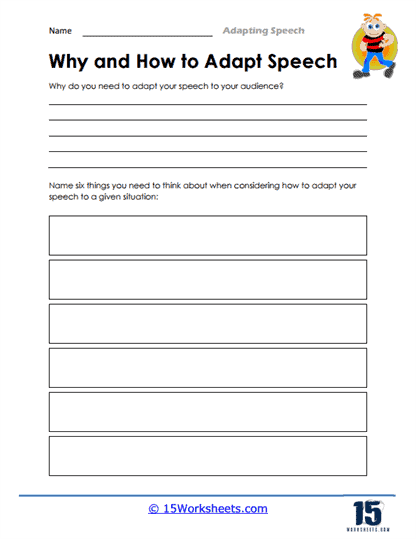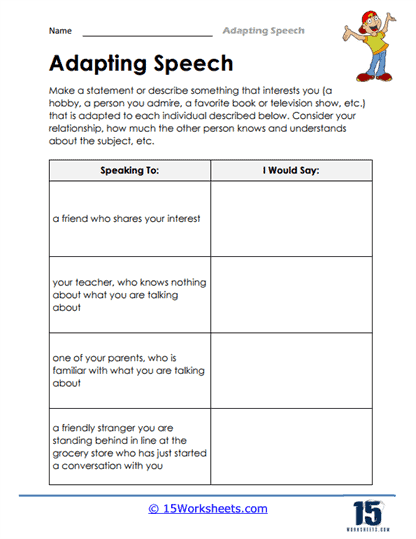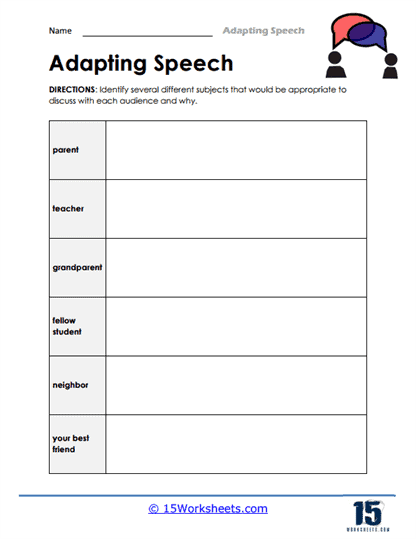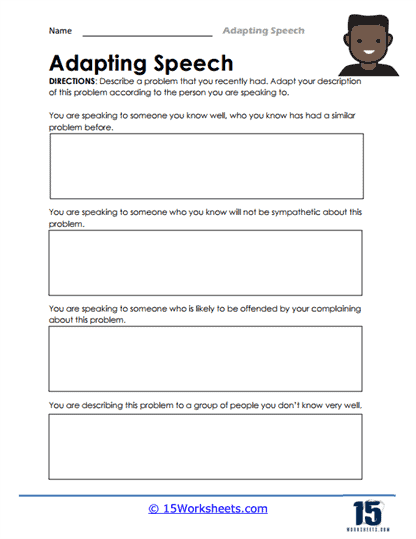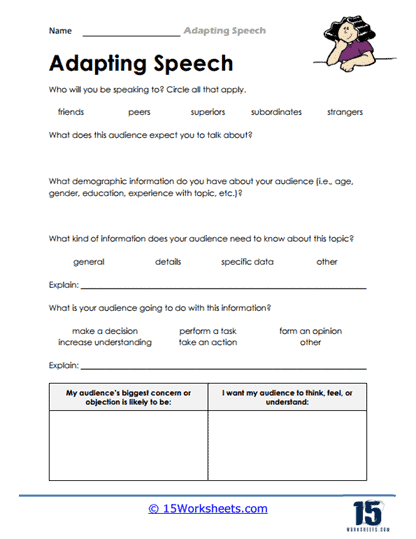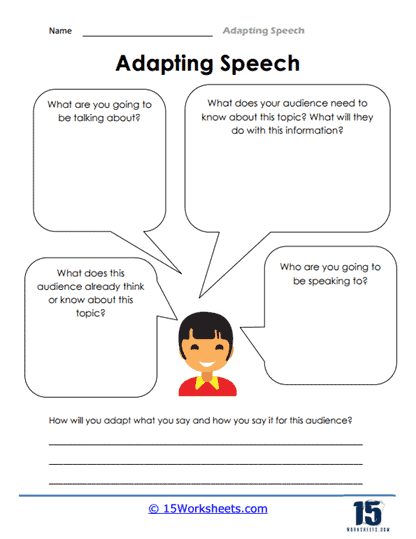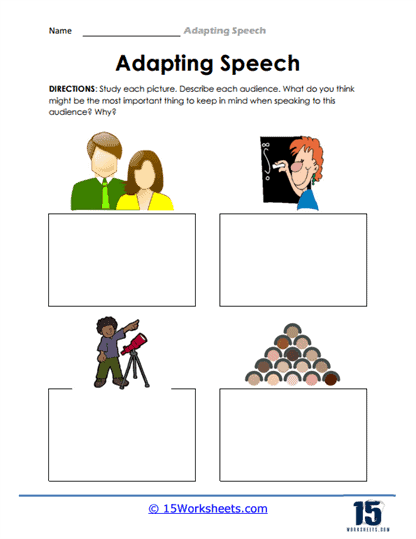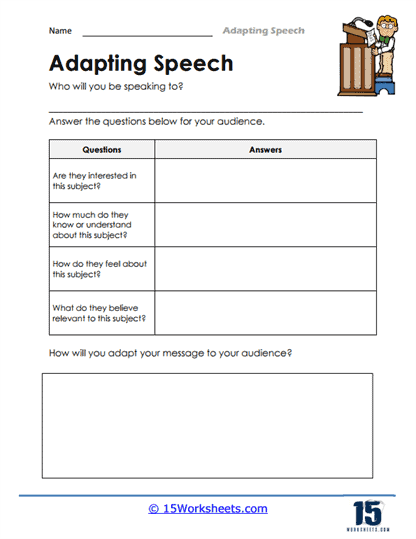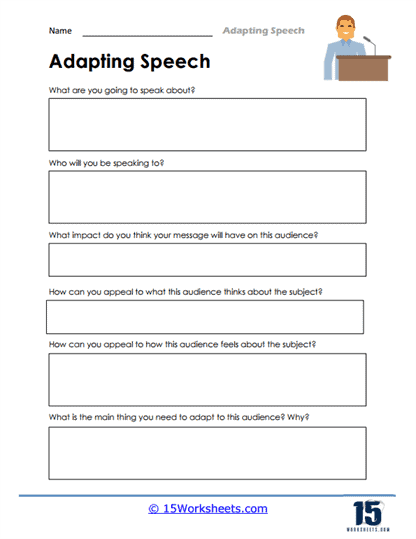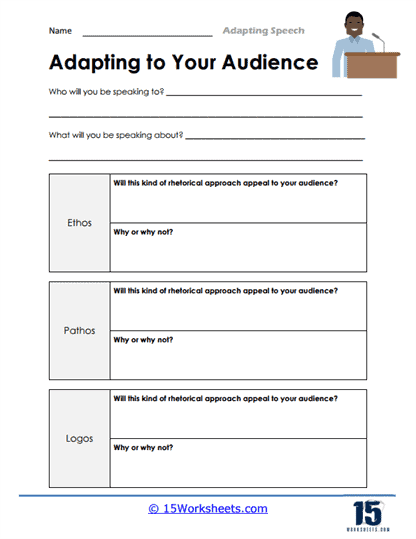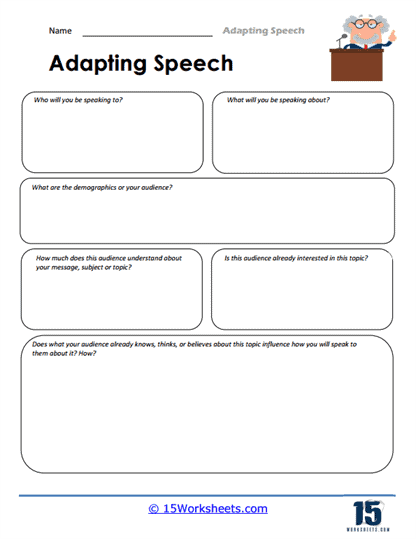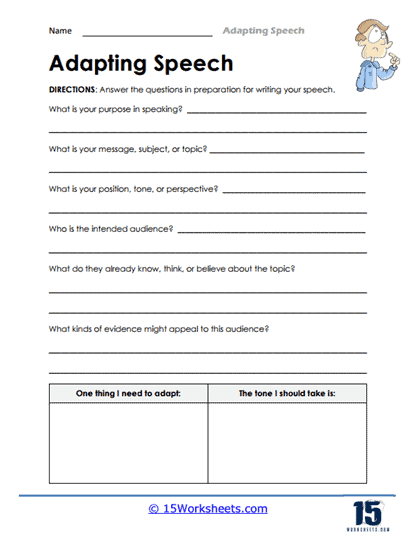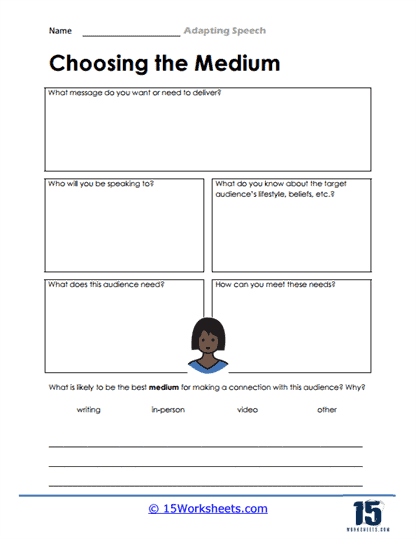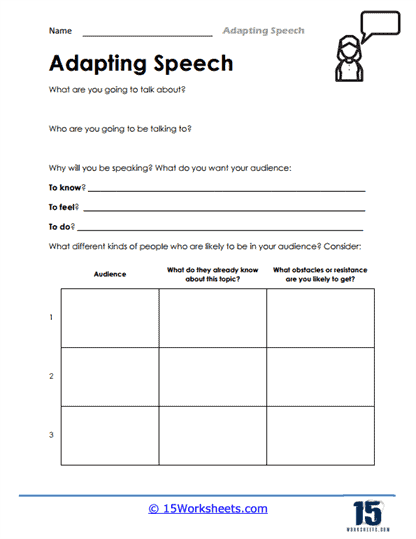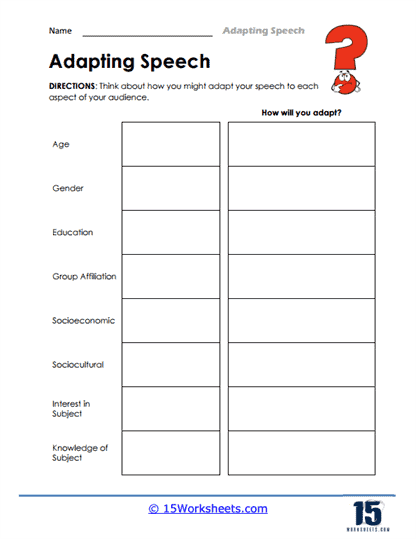Adapting Speech Worksheets
All About These 15 Worksheets
Effective communication involves more than just speaking; it requires the ability to adapt one’s message to different audiences. These series of worksheets have been designed to help students develop the crucial skill of adapting their speeches to suit their listeners. Through a combination of practical exercises and thoughtful analysis, students will gain a deeper understanding of audience dynamics and learn techniques to tailor their speeches effectively.
The 15 worksheets in this series provide a comprehensive framework for students to navigate the intricacies of adapting speech. Each worksheet focuses on a specific aspect of audience adaptation, guiding students through various considerations and strategies to ensure their message resonates with their listeners. From understanding the audience’s perspective to crafting engaging introductions and structuring compelling arguments, these worksheets cover essential elements of successful speech adaptation. Through these worksheets, students will:
- Identify and analyze key audience characteristics such as age, education level, cultural background, and interests;
- Build credibility and establish a connection with their listeners;
- Explore strategies for selecting speech topics that align with their audience’s interests and current trends;
- Develop skills in using vivid language, rhetorical devices, and storytelling techniques to engage their audience;
- And practice creating outlines that ensure their speech is coherent and easy to follow.
In summary, this series offers a structured and comprehensive approach to mastering the art of adapting speeches to different audiences. By practicing the techniques and strategies outlined in each worksheet, students will develop the skills necessary to communicate effectively, engage their listeners, and deliver impactful speeches in a variety of contexts.
Why Do We Need to Adapt Speeches for Different Audiences?
Adapting speeches for different audiences is crucial for effective communication because it ensures that the message is well-received, understood, and impactful. There are several reasons why it’s important to tailor speeches according to the audience:
Cultural Sensitivity
Different cultures may have unique customs, beliefs, and values that need to be considered when delivering a speech. Adapting your speech to respect these differences can prevent misunderstandings and offense.
Relevance
Different audiences have different needs, interests, and backgrounds. Adjusting your speech to address specific concerns or interests makes it more relevant and engaging for the listeners.
Comprehension
People have varying levels of understanding, depending on their education, expertise, and familiarity with the topic. Adapting your speech to match the audience’s knowledge level ensures that your message is clear and comprehensible.
Establishing Credibility
Demonstrating that you understand your audience’s perspectives and needs can help establish your credibility and build rapport. This will make your audience more receptive to your message.
Emotional Appeal
Different audiences may respond differently to various emotional appeals. Adapting your speech to evoke emotions that resonate with the audience can make it more persuasive and memorable.
Attention Span
Different audiences have varying attention spans. Younger generations, at this current time period, have much shorter attention spans. Adapting your speech to maintain interest and focus is important to ensure your message is effectively communicated.
Language and Jargon
Depending on your audience, using technical terms and jargon may be appropriate or inappropriate. Adjusting your language and terminology to match your audience’s understanding can enhance clarity and minimize confusion.
How to Adapt a Speech
Adapting a speech for a different audience involves understanding the audience’s needs, interests, and backgrounds, and making adjustments to the content, tone, and delivery to ensure effective communication. Here are some strategies to adapt a speech for a different audience:
- Analyze the audience. Research your audience’s demographics, cultural background, interests, and knowledge about the topic. Understand their needs, preferences, and concerns to tailor your speech accordingly.
- Set clear objectives. Determine the primary purpose of your speech, whether it’s to inform, persuade, entertain, or inspire. This will guide you in structuring your content to achieve your desired outcome.
- Use appropriate language. Choose words and phrases that are easily understood by your audience, avoiding jargon or technical terms that may confuse or alienate them. If necessary, provide definitions or explanations for unfamiliar terms.
- Adjust your tone and style. Adapt your tone and style to match your audience’s expectations and preferences. For example, a formal tone might be appropriate for a professional audience, while a more casual tone could be suitable for a younger or more informal audience.
- Personalize your content. Use examples, anecdotes, or case studies that are relevant and relatable to your audience. This will make your speech more engaging and help illustrate your points.
- Organize your speech logically. Arrange your content in a clear, logical manner to facilitate understanding. Use signposts, transitions, and summaries to help guide your audience through your speech.
- Adapt your delivery. Adjust your pacing, volume, and body language to suit the audience’s preferences and the size of the venue. Maintain eye contact and engage with your audience to establish a connection.
- Consider cultural sensitivity. Be aware of cultural differences that may impact how your message is received. Avoid offensive language or gestures, and respect local customs and traditions.
- Use visual aids wisely. If using visual aids, ensure they are clear, simple, and relevant to your audience. Make sure they complement and support your speech without being distracting.
- Be flexible and adaptable. Be prepared to adjust your speech on the fly based on audience reactions and feedback. Be willing to answer questions, address concerns, or clarify points as needed.
By employing these strategies, you can effectively adapt your speech to resonate with different audiences, ensuring your message is clear, engaging, and impactful.

